 The blackberry mushroom, which grows in coniferous or mixed forests mainly under pine trees, is classified as edible or conditionally edible in various reference books. The taste qualities of all types of blackberry (variegated, yellow and others) are low, however, these mushrooms may well be used in cooking, as they do not contain toxic substances.
The blackberry mushroom, which grows in coniferous or mixed forests mainly under pine trees, is classified as edible or conditionally edible in various reference books. The taste qualities of all types of blackberry (variegated, yellow and others) are low, however, these mushrooms may well be used in cooking, as they do not contain toxic substances.
We bring to your attention a photo of the blackberry mushroom of various varieties, as well as a description of these gifts of the forest and recommendations for their use.
Hedgehog motley (motley)
Category: conditionally edible.
Hat Sarcodon imbricatus (diameter 4-15 cm): brown or grayish, with darker scales arranged in even circles. In young mushrooms, the scales are soft and velvety, but over time they become quite hard and larger. In adulthood, they can completely fall off, leaving the surface of the cap absolutely smooth. The shape gradually changes from convex to depressed, and sometimes becomes funnel-shaped.

Pay attention to the photo of the blackberry cap – which are initially raised, then bent inward.
Thanks to the outgrowths-scales on the hat, the mushroom received the name of blackberry tile in Latin.
Leg (height 2-6 cm): smooth or slightly fibrous, the same color as the cap, rarely purple or lilac. Strong and thick, cylindrical in shape and tapering from bottom to top. It happens both hollow and solid.
[ »»]
Pulp: dirty white or grayish, young mushrooms are juicy, with a pleasant spicy aroma, old ones are dry and hard, with a smell of rot.
The variegated urchin was first described by Carl Linnaeus in 1753.
Doubles: the rough blackberry (Sarcodon scabrosus), but with a much smaller cap, and the very rare cone-shaped cone fungus (Strobilomyces floccopus), which has a more variegated cap.
Other names: blackberry tile, blackberry scaly, sarcodon tile, sarcodon motley, kolchak, hawk.
When growing: from mid-August to mid-October in the countries of the Eurasian continent with a temperate climate.
Where can I find: on sandy soils of coniferous or mixed forests, most often near pines.
Eating: considered to be of low quality. Young blackberries are suitable for salting or as a seasoning, but only after mandatory boiling for 8-10 minutes.
Application in traditional medicine: does not apply.
Important! Raw variegated urchins can cause very severe eating disorders, so it is recommended to consume them only after heat treatment.
Mushroom blackberry comb
Category: edible.
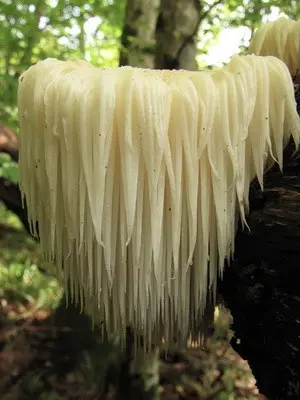

Fruit body Hericium erinaceus (Hericium erinaceus) (up to 25 cm, weight about 2 kg): cream, yellowish or white, usually round, oval or irregular in shape.
Pulp: fleshy, white in color, which changes to yellowish when dry.
Doubles: are absent.
When growing: from early August to mid-October in the Crimea, the Far East and China.
Where can I find: on the trunks of weakened or diseased trees, most often at the site of a break in the bark or branches of birches, beeches or oaks.
Eating: Hericium erinaceus is a rare mushroom and therefore not widely available. It tastes like shrimp meat.
Use in traditional medicine (data are not confirmed and have not been clinically tested!): for the treatment of diseases of the gastrointestinal tract – gastritis, ulcers, stomach cancer.
It is widely used in oriental medicine as a powerful immunostimulant.
Other names: hericium comb, mushroom noodles, lion’s mane.
The French call the combed blackberry Pom-Pom blanc, that is, “pom-pom mushroom”, the Chinese – “houtougu” – “monkey’s head”, and the British – lion’s mane mushroom, which means “lion’s mane”. The Japanese name “yamabushitake” is also quite common.
[ »wp-content/plugins/include-me/ya1-h2.php»]
Blackberry yellow and mushroom photo
Category: edible.
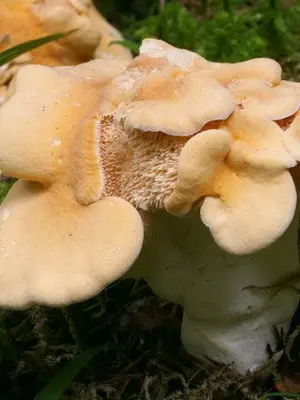

head yellow urchin (Hydnus must be returned) (diameter 4-15 cm): light red or light orange, darkens noticeably as it ripens or when pressed hard. Very uneven, dense and fleshy, slightly convex, almost flat in the old mushroom. The edges are usually bent down. On the inside of the cap there are spines, thanks to which the urchin got its name. If the mushroom grows in a well-lit place, it fades strongly under the influence of sunlight and becomes almost white or light yellow.
Leg (yellow blackberry height 2-8 cm): cylindrical shape, usually expanding downward. Often curved, with a smooth and dry surface. Usually yellow, like the cap, darkens as it matures.
Pulp: white or yellow, very brittle. As the fungus ages, it darkens and becomes hard. It has a rich fruity scent. The old blackberry has a bitter taste.
Application in traditional medicine: does not apply.
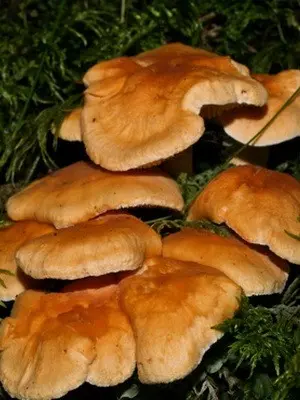
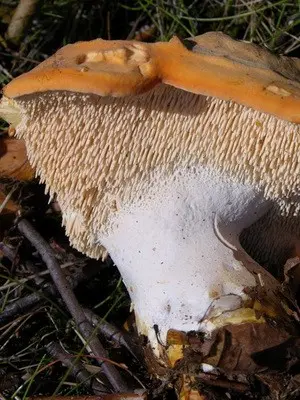
Doubles: edible red-yellow blackberry (Hydnum rufescens). Only it is smaller in size and has a more intensely colored hat.
When growing: from mid-June to the end of October in the temperate climate of the countries of the Eurasian continent and North America, practically throughout Our Country.
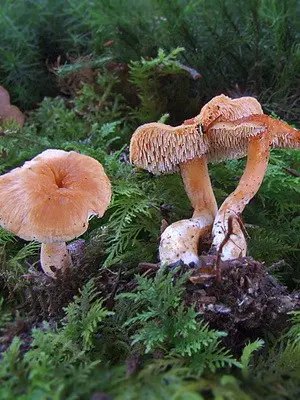
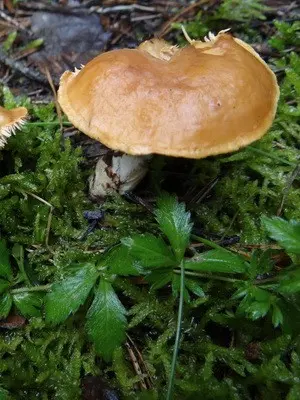
Where can I find: on calcareous soil in coniferous and deciduous forests, often near birches and small shrubs. They can form wide “witch circles”.
Eating: in almost any form – fried, boiled or pickled. But first it is necessary to soak in order to remove possible residual bitterness.
Other names: notched blackberry, notched hydnum, notched dentinum, deaf chanterelle.









